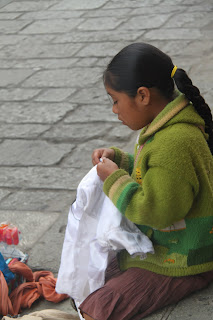
This guy sharpens knives, scissors, tools, whatever has an edge, for housewives, salons or restaurants. The bicycle has been modified so it has one wheel and a grinding stone mounted on the handlebars. He pedals to turn the grinding stone. When he is done, he tips the bike and pushes it down the street on its wheel, onto the next customer.
Knife sharpening is a tough way to make a living, very low pay. There is a saying that goes, you are as poor as the knife sharpener's dog who eats the sparks in order to have something hot to eat.
 Mercado San Juan in the center of Mexico City. The goose barnacles took me back to my days at Everest Restaurant where these were served steamed. The cross-section of ahi tuna looks like a face, doesn't it?. A happy cat in a fish market? The vendor told me that the orange fish was a blowfish but I have my doubts. It was some type of fish that used air to raise and lower itself.
Mercado San Juan in the center of Mexico City. The goose barnacles took me back to my days at Everest Restaurant where these were served steamed. The cross-section of ahi tuna looks like a face, doesn't it?. A happy cat in a fish market? The vendor told me that the orange fish was a blowfish but I have my doubts. It was some type of fish that used air to raise and lower itself. Finally dorado, also known as mahi mahi, is very colorful.
Finally dorado, also known as mahi mahi, is very colorful.





















































